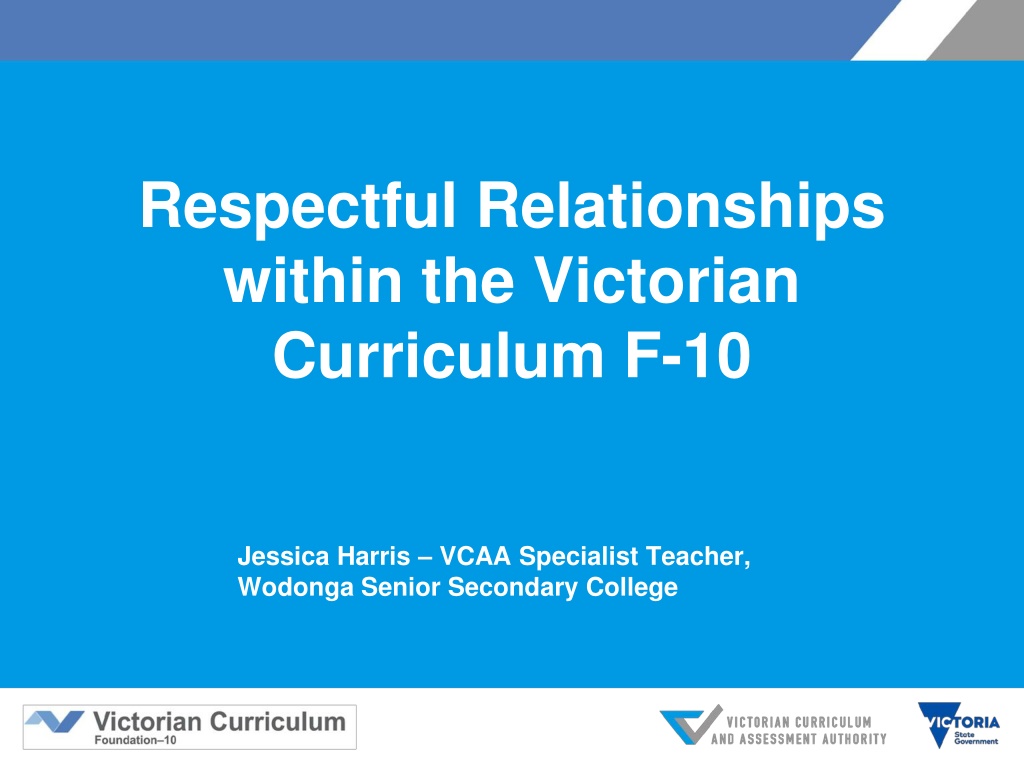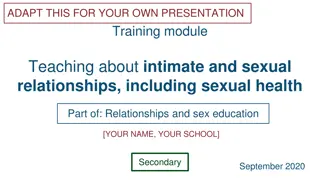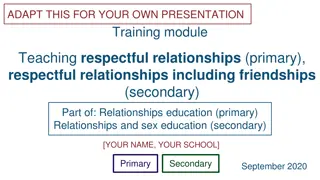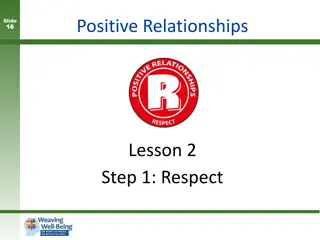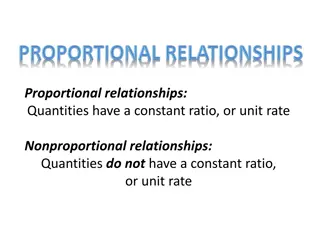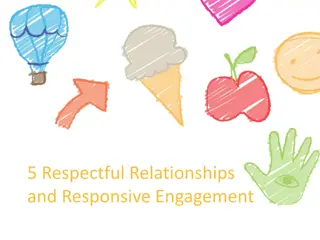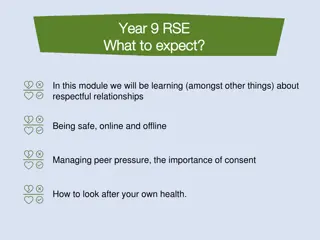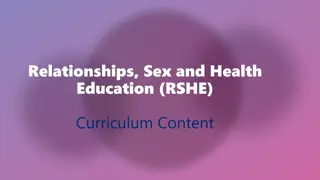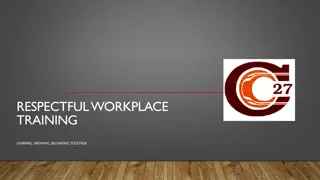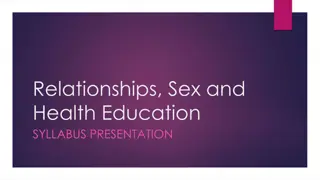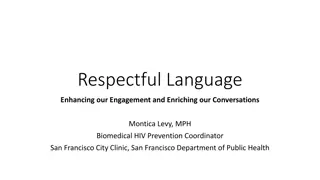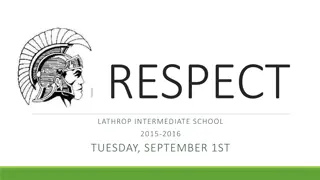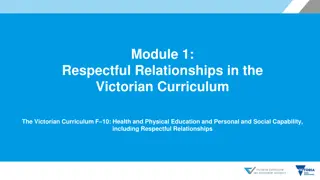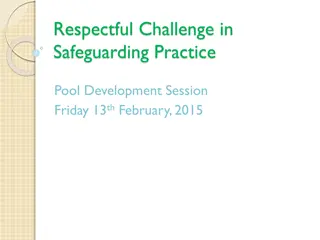Understanding and Implementing Respectful Relationships in Education
Explore the importance of respectful relationships in the Victorian Curriculum, focusing on primary prevention of gender-based violence through education. Learn how to implement a holistic approach towards creating a future free from violence in schools. Address gender roles and stereotypes to promote healthy relationships among young people. Navigate challenging topics with an open mind and access support resources when needed.
- Respectful relationships
- Victorian Curriculum
- Gender-based violence prevention
- Education program
- Healthy relationships
Download Presentation

Please find below an Image/Link to download the presentation.
The content on the website is provided AS IS for your information and personal use only. It may not be sold, licensed, or shared on other websites without obtaining consent from the author. Download presentation by click this link. If you encounter any issues during the download, it is possible that the publisher has removed the file from their server.
E N D
Presentation Transcript
Respectful Relationships within the Victorian Curriculum F-10 Jessica Harris VCAA Specialist Teacher, Wodonga Senior Secondary College
Session Aims: To become familiar with where respectful relationships is reflected in the Victorian Curriculum To explore the importance of respectful relationships in today s society To develop an understanding of the content of the Respectful Relationships resources To consider starting points to begin implementing an excellent Respectful Relationships Education program in your school setting
Warning Some of the material covered today may be challenging or upsetting We encourage an open mind and willingness to look critically at the content It is ok to take a moment outside to acknowledge any feelings or emotions you may experience National 1800RESPECT Line Telephone and online counselling and information 1800 737 732
Children must be taught how to think, not what to think - Margaret Mead
Respectful Relationships Definition Respectful Relationships Education is the holistic approach to school-based, primary prevention of gender-based violence. It uses the education system as a catalyst for generational and cultural change by engaging schools, as both educational institutions and workplaces to comprehensively address the drivers of gender- based violence and create a future free from such violence. Our Watch Victoria, Respectful Relationships Education in Schools: Evidence Paper, December 2015
Why teach respectful relationships? Royal Commission into Family Violence: Evidence is clear that a contributor to gender-based and family violence is strict adherence to gender roles, and gender stereotyping. The aim of respectful relationships is to change these attitudes in young people, so that as they enter into intimate relationships they are less likely to engage in gender-based or family violence. Respectful Relationships as school-based primary prevention has been a strong focus of the Royal Commission into Family Violence.
Royal Commission into Family Violence
True / False Statistics For each of the following statistics, respond whether you believe the statistic to be True or False.
True / False Statistics 1 in 3 Australian women have experienced physical violence since the age of 15
True / False Statistics 1 in 3 Australian women have experienced physical violence since the age of 15 True (ABS 2012) Aboriginal and Torres Strait Islander women experience both far higher rates and more severe forms of violence compared to other women. Violence against women is not limited to the home or intimate relationships. Every year in Australia over 300,000 women experience violence - often sexual violence - from someone other than a partner.7
True / False Statistics The Australian Bureau of Statistics Personal Safety Survey (2005) found that 30% of women surveyed reported that the violence had been witnessed by children
True / False Statistics The Australian Bureau of Statistics Personal Safety Survey (2005) found that 30% of women surveyed reported that the violence had been witnessed by children The percentage is actually higher - 59%
True / False Statistics Research has found that violence- supportive cultures are evident (to varying degrees) in schools
True / False Statistics Research has found that violence- supportive cultures are evident (to varying degrees) in schools -Ellis 2008
True / False Statistics Having friends or knowing other young people who are experiencing violence in their romantic relationships is a significant preventative factor for violence.
True / False Statistics Having friends or knowing other young people who are experiencing violence in their romantic relationships is a significant preventative factor for violence. False - It is NOT. It is actually a risk factor. This may normalise violence, or may represent contact with delinquent peers. However, peer influence may also be positive: there is evidence that peers are an important source of support for children living with domestic violence.
True / False Statistics Approximately one in ten Australian Year 4 to Year 9 students report being bullied every few weeks or more often (considered to be frequent) during the last term at school.
True / False Statistics Approximately one in ten Australian Year 4 to Year 9 students report being bullied every few weeks or more often (considered to be frequent) during the last term at school. False 1 in 4 (27%) in 2016 see bullying no way .com
A few more statistics for you One in five Australian women has experienced sexual violence. One in four Australian women has experienced physical or sexual violence by an intimate partner. Women are at least three times more likely than men to experience violence from an intimate partner. Women are five times more likely than men to require medical attention or hospitalisation as a result of intimate partner violence, and five times more likely to report fearing for their lives. Domestic or family violence against women is the single largest driver of homelessness for women,a common factor in child protection notifications and results in a police call-out on average once every two minutes across the country. The combined health, administration and social welfare costs of violence against women have been estimated to be $21.7 billion a year, with projections suggesting that if no further action is taken to prevent violence against women, costs will accumulate to $323.4 billion over a thirty-year period from 2014-15 to 2044-45.
What about violence against men? Women 1 in 3 1 in 5 1 in 4 Men 1 in 2 1 in 22 1 in 7 Physical Sexual Emotional Physical or sexual abuse by a current or former partner? Women = 1 in 6 Men = 1 in 19
Whole school approach The Victorian Curriculum F-10 provides the basis for the design of teaching and learning programs. Content descriptions identify what teachers are expected to teach and what students are expected to learn Achievement standards describe what students are typically able to do and are the basis for assessment and reporting student achievement
Respectful relationships in the Victorian Curriculum The development of respectful relationships teaching and learning programs in schools will draw upon: Health and Physical Education Personal and Social Capability. The two curricula are complementary The Personal and Social Capability (P&SC) involves learning to recognise and regulate emotions, develop empathy for others and understand relationships, establish and build a framework for positive relationships, work effectively in teams and develop leadership skills HPE enables students to recognise personal qualities, understand identity and strategies for respectful relationships Together HPE and P&SC develops knowledge and skills to promote respectful relationships that are safe and equitable.
Health and Physical Education Structure Strands and sub-strands Movement and Physical Activity Strands Personal, Social and Community Health Sub-strands Moving the body Being healthy, safe and active Understanding movement Communicating and interacting for health and wellbeing Learning through movement Contributing to healthy and active communities Achievement standards The first achievement standard at Foundation and then at Levels 2, 4, 6, 8 and 10. A curriculum for students with disabilities is provided in this learning area.
HPE Structure - Focus areas The focus areas provide the context through which the Content Descriptors and Achievement Standards are taught and assessed Alcohol and other drugs Active play and minor games Food and nutrition Challenge and adventure activities Health benefits of physical activity Fundamental movement skills Mental health and wellbeing Games and sports Lifelong physical activities Relationships and sexuality Rhythmic and expressive movement Safety
Health and Physical Education Achievement Standard Levels 9 & 10 Levels 3 & 4 By the end of Level 4, students recognise strategies for managing change. By the end of Level 10, students critically analyse contextual factors that influence their identities, relationships, decisions and behaviours. They examine influences that strengthen identities. They analyse the impact of attitudes and beliefs about diversity on community connection and wellbeing. They evaluate the outcomes of emotional responses to different situations. They investigate how emotional responses vary and understand how to interact positively with others in different situations including in physical activities. Students access, synthesise and apply health information from credible sources to propose and justify responses to situations in the home, in the school and the community. Students interpret health messages and discuss the influences on healthy and safe choices. They understand the benefits of being fit and physically active. Students propose and evaluate interventions to improve fitness and physical activity levels in their communities. They examine the role physical activity has played historically in defining cultures and cultural identities. They describe the connections they have to their community and how these can promote health and wellbeing.
Health and Physical Education Achievement Standard Levels 9 & 10 Levels 3 & 4 Students apply strategies for working cooperatively and apply rules fairly. Students identify and analyse factors that contribute to respectful relationships. They explain the importance of cooperation, leadership and fair play across a range of health and movement contexts. They select and demonstrate strategies that help them stay safe, healthy and active at home, at school and in the community. They compare and contrast a range of actions that could be undertaken to enhance their own and others health, safety and wellbeing. They refine fundamental movement skills and apply movement concepts and strategies in different physical activities and to solve movement challenges. They create and perform movement sequences using fundamental movement skills and the elements of movement. They apply and transfer movement concepts and strategies to new and challenging movement situations. They apply criteria to make judgments about and refine their own and others specialised movement skills and movement performances. They work collaboratively to design and apply solutions to movement challenges.
Personal and Social Capability Structure Strands and Sub-strands Self-Awareness and Management Recognition and expression of emotions Development of resilience Social Awareness and Management Relationships and diversity Collaboration Achievement standards The first achievement standard at Foundation and then at Levels 2, 4, 6, 8 and 10. A curriculum for students with disabilities will be developed in this learning area.
Personal & Social Capability Achievement Standard Levels 9 & 10 Levels 3 & 4 By the end of Level 4, students explain the consequences of emotional responses in a range of social situations. They recognise personal strengths and challenges and identify skills they would like to develop. They suggest strategies for coping with difficult situations. They persist with tasks when faced with challenges and adapt their approach when first attempts are not successful. Students discuss the value of diverse perspectives and through their interactions they demonstrate respect for a diverse range of people and groups. They describe factors that contribute to positive relationships with peers, other people at school and in the community. They explain characteristics of cooperative behaviours and they use criteria to identify evidence of this in group activities. They identify a range of conflict resolution strategies to negotiate positive outcomes to problems. By the end of Level 10, students reflect critically on their emotional responses to challenging situations in a wide range of contexts. They demonstrate persistence, motivation, initiative and decision- making through completion of challenging tasks. They evaluate personal characteristics, strategies and sources of support used to cope with stressful situations/life challenges. Students analyse the effects of actions that repress human rights and limit the expression of diverse views. They analyse factors that influence different types of relationships. They critique their ability to devise and enact strategies for working in diverse teams, drawing on the skills and contributions of team members to complete complex tasks. They develop and apply criteria to evaluate the outcomes of group tasks and make recommendations for improvements. They generate, apply and evaluate strategies to prevent and resolve conflicts in a range of contexts.
Progression of learning - poll Foundation Levels 1-2 Levels 3-4 Levels 5-6 Levels 7-8 Levels 9-10 A B C Describe what it means to be confident, adaptable and persistent and why these attributes are important in dealing with new or challenging situations Analyse the significance of independence and individual responsibility in the completion of challenging tasks Explain how being prepared to try new things can help identify strategies when faced with unfamiliar or challenging situations 1. Which content description represents the lower level of knowledge/skills? (A, B or C?) 2. Which content description represents the higher level of knowledge/skills? (A, B or C?)
Progression of learning - poll Foundation Levels 1-2 Levels 3-4 Levels 5-6 Levels 7-8 Levels 9-10 Level 5-6 Level 9-10 Level 1-2 Describe what it means to be confident, adaptable and persistent and why these attributes are important in dealing with new or challenging situations Analyse the significance of independence and individual responsibility in the completion of challenging tasks Explain how being prepared to try new things can help identify strategies when faced with unfamiliar or challenging situations Refer to the scope and sequence document
Continuum of learning Increasing complexity Level 5-6 Practise skills to establish and manage relationships Level 3-4 Describe factors that can positively influence relationships and personal wellbeing Level 7-8 Investigate the benefits of relationships and examine their impact on their own and others health and wellbeing Level 9-10 Investigate how empathy and ethical decision- making contribute to respectful relationships Health and Physical Education content descriptions
Working with the curriculum Achievement Standard (part of) Focus Area/s Teaching and learning activities Content Description Assessment strategy Health and Physical Level 5-6 Investigate resources to manage changes and transitions associated with puberty Catching on Early - Changes for boys, girls and both sexes - Coping with body changes - Growing up kit Students investigate developmental changes and transitions. Education Dear Abby student response to letters RS MH Personal and Social Capability Level 9-10 Develop specific skills and a variety of strategies to prevent or resolve conflict, and explore the nature of conflict resolution in a range of contexts Scenarios and problem solving worksheet from RRRR resource (topic 4) Class discussion and exploration around assertive, submissive and aggressive statements Create an interactive game which demonstrates an understanding of problem solving and following through with positive actions and assertive statements using the RRRR Solve it! Six steps for problem solving They generate, apply and evaluate strategies to prevent and resolve conflicts in a range of contexts.
Explicit teaching and assessment The Personal and Social Capability describes social and emotional learning as discrete knowledge, understandings and skills, rather than a statement of pedagogy For example, just because a student completes a task as part of the team, this does not mean that they acquire the knowledge, understandings and skills necessary to work collaboratively with others. The knowledge, understandings and skills for working collaboratively, such as communication, negotiation, time management and conflict resolution, need to be explicitly taught and assessed. Successful social and emotional learning programs move beyond giving information to explicitly teaching and providing opportunity for students to practise interpersonal skills.
How would you assess this? An example Level 7-8 Content descriptor: Recognise the impact of personal boundaries, intimacy, distribution of power and social and cultural norms and mores on the ways relationships are expressed Possibilities Case studies Group discussion Test Roleplay Reflective writing Assignment Story boarding Mind mapping Other ideas? Achievement standard (part of): They identify indicators of respectful relationships in a range of social and work-related situations.
DET Resources Available now on FUSE: http://fuse.education.vic.gov.au/ResourcePackage/ByPin?pin=2JZX4R
DET Resources Unit 1: Gender, respect & relationships Unit 2: The Power connection Unit 3: Gender, power & media http://fuse.education.vic.gov.a u/ResourcePackage/ByPin?pin =H9WQYK
Building Resilience Social and Emotional Learning materials (F-12) Emotional literacy Personal strengths Positive coping Problem solving Stress management Help seeking Gender and Identity Positive Gender Relations https://fuse.education.vic.gov.au/p ages/View.aspx?pin=5DZ88S
Which of these 8 topics do you believe is most needed at your school? Emotional literacy Personal strengths Positive coping Problem solving Stress management Help seeking Gender and Identity Positive Gender Relations
Remember the facts Respectful Relationships Education is part of the new Victorian Curriculum it is not an add-on or an additional program, it must be taught in all schools. The Personal and Social Capability and Health and Physical Education outline the progression of topics in an age-appropriate, research-based manner. The Government has accepted all recommendations from the Royal Commission into Family Violence. Teaching about respectful relationships is one of these recommendations. Gender-based violence is very real it has been labelled an epidemic in recent reports. Don t forget the statistics http://www.aph.gov.au/Parliamentary_Business/Committees/Senate /Finance_and_Public_Administration/Domestic_Violence/Report
The 7 elements of best practice (Our Watch, 2015) 1. Addresses drivers of gender-based violence 2. Have a long term vision, approach and funding 3. Take a whole school approach 4. Establish mechanisms for collaboration and coordinated effort 5. Ensure integrated evaluation and continual improvement 6. Provide resources and support for teachers 7. Use age-appropriate, interactive, inclusive and participatory curriculum teaching and learning
The standard you walk past, is the standard you accept. - Army Chief, Lieutenant General David Lindsay Morrison
Jessica Harris VCAA Specialist Teacher Personal and Social Capability and Health and Physical Education Nerida Matthews Curriculum Manager matthews.nerida.a@edumail.vic.gov.au Further reading: http://www.theaustralian.com.au/opinion/respectful-relationships-education- teaching-kids-respect/news-story/c5547247977056d85c085aed23004bf6
